News From the Festival
Ten Facts about The Pirates of Penzance
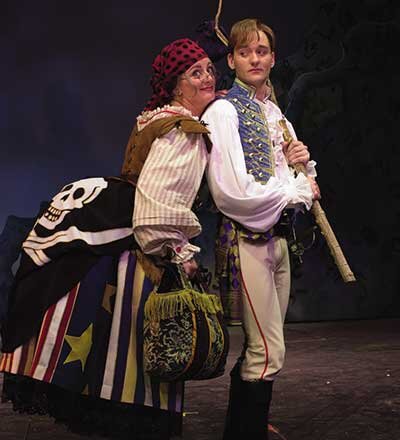
Laurie Birmingham (left) as Ruth and Glenn Seven Allen as Frederick in the Festival’s 2001 production of The Pirates of Penzance.
By Parker Bowring
Witty, comedic, and heartfelt, the Pirates of Penzance is a play the whole family will love. With larger-than-life characters and a plot rife with laughter, warmth, and sparkling music, this play has so much to offer adults and children alike.
“Nothing is what it appears to be,” said director Cassie Abate. “The rough pirates are sentimental. The brave policemen are scaredy cats. The major general has very limited military knowledge.”
In fact, the play, and the story of its creation, are full of fun and surprising facts. Here are just ten:
-
Part of the inspiration for the The Pirates of Penzance was the literal piracy of Gilbert and Sullivan’s work—most notably H.M.S. Pinafore which saw unlicensed (pirated) versions performed throughout the United States.
-
To avoid this problem of unlicensed American productions, The Pirates of Penzance played in England for one performance, then opened in New York City the next night, thus securing both British and American copyrights.
-
When the play had its actual run in England, it played for almost a year, after 363 performances.
-
Gilbert and Sullivan wrote fourteen operettas. The Pirates of Penzance is their fifth.
-
Gilbert and Sullivan were known for creating topsy turvy worlds where characters behave logically in completely illogical circumstances.
-
The Song “I Am the Very Model of a Modern Major General” is Gilbert and Sullivan’s most famous patter song and has been parodied or pastiched in books, movies, television shows, songs, and musicals.
-
In The Pirates of Penzance, Gilbert and Sullivan poked fun at another of their plays, H.M.S. Pinafore. In the second verse of “A Modern Major-General.” Major-General Stanley sang: “I can . . . whistle all the airs from that infernal nonsense Pinafore.
-
The playwrights also spoofed operatic conventions, particularly one employed by many serious operas of the time that called for different characters to sing onstage at the same time yet remain oblivious to each other’s presence. The trick is especially humorous in Act 2, when the pirate-hunting policemen fail to notice those pirates who have just stalked onstage singing “With Cat-Like Tread.”
-
Another opera insiders’ joke occurs in Mabel’s entrance aria, in which she and a single flute engage in a highly ornamented duet that would have brought to many opera lovers’ minds the similar interchange in the mad scene of Gaetano Donizetti’s Lucia di Lammermoor.
-
In the opening number the pirates pass around a “pirate bumper” which is a cup filled to the brim.
What Exactly Is a Comic Operetta?
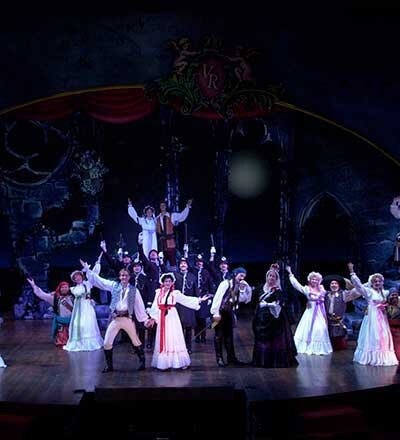
A scene from The Pirates of Penzance, 2001.
By Parker Bowring
Sentimental pirates, bumbling policemen, nobles, and giggling maidens, oh my! All weaved together in a comic operetta that has it all, the Pirates of Penzance. But what is a comedic operetta, you may ask?
Well, I’m glad you asked. “Operetta, or comic opera, really serves as the link between opera and musicals,” explained The Pirates of Penzance director Cassie Abate. “Operettas are usually comical and satirical in natural and contain large portions of dialogue between sung musical numbers. Operetta laid the groundwork for twentieth century American musical theatre.” Operettas are usually shorter than typical operas and showcase characters that are light and amusing.
According to Britannica.com, operettas are “musical-dramatic productions similar in structure to a light opera but characteristically having a romantically sentimental plot interspersed with songs, orchestral music, and rather elaborate dancing scenes, along with spoken dialogue.”
“The Pirates of Penzance is satire and parody at its finest, full of whimsy, humor, and wit. While the show parodies many conventions of grand opera, the music parallels the best from the genre: it is both a burlesque and a love letter,” said Abate. By being a comic operetta, the Pirates of Penzance fits in with other genres because it has both music and comedy. It showcases characters who are warm and hilarious at the same time.
“The characters in Pirates of Penzance are larger than life—and nothing is what it appears to be. I think children will love seeing how much chaos ensues around these whimsical characters,” said Abate. “Also, our production is finding additional ways to incorporate dance—so get ready for kicklines, tap dancing, and fun leaps, lifts, and turns!”
Full of laughter, music, dancing, and heartfelt characters, the Pirates of Penzance is a comic operetta for the whole family.
Festival Announces Changes in Production and Artistic Leadership


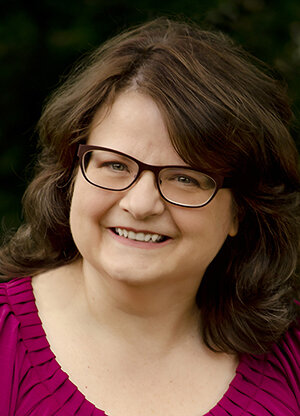
Richard Girtain
Dan Giedeman
Tanya J. Searle
The Utah Shakespeare Festival recently announced changes to three management positions in its production and artistic areas. Two new people have been hired to fill vacancies, and another has taken on additional duties.
Richard Girtain has been hired in the role of production manager. As such, he is the overall supervisor and coordinator of all aspects of costumes, lights, audio, scenery, and props for the Festival plays. He oversees all departmental budgeting, scheduling, staffing, and coordination efforts and supervises all stages of the production process including design, budgeting, rehearsal, and performance.
Girtain most recently worked as the technical director for the Juilliard School in New York City. He holds a BA in theatre and religious studies from the University of Tennessee and an MFA in technical production from Florida State University. He has worked on over 200 professional productions throughout the United States and abroad and is the co-author of The Technical Director’s Toolkit from Focal Press. He has worked for the Festival before in various scenery positions from 2003 to 2008.
He is excited to be returning to Cedar City, along with his wife Diane and children Jack and Grace. “The Utah Shakespeare Festival, SUU, and Cedar City have collaborated to create a truly special environment that fosters the exploration of the human condition,” he said when speaking about returning to the Festival. “The investment in art, education, and community is a rare example of what is possible when we come together."
Dan Giedeman was recently hired as the Festival’s scenery director, reporting to the new production manager. As such, he is responsible for the organization and management of the scenery and paint department, including budgeting, hiring, drafting, construction, maintenance, and striking of all scenic elements of the Festival productions.
Giedeman comes to the Festival from Saint Louis University where he is an assistant professor of theatre. He is also familiar with the Festival, having worked here for sixteen seasons since 1997. He has worked at such theatres as Opera Theatre of Saint Louis, Repertory Theatre of Saint Louis, Orlando Shakespeare Festival, and Actor’s Theatre of Louisville and at Mystic Studios and Image Technologies (a professional industrial theatrical company). He served in the U. S. Army from 1989 to 1992, when he was honorably discharged.
“I am excited to begin this full-time journey with the Festival serving as scenery director,” he said. “The Festival has always been a place where I could renew my passion for theatre and the arts, and I am eager to explore the possibilities it will offer in a more significant way.”
Tanya J. Searle, the Festival stage manager, has taken on the additional role of artistic associate. Thus, in addition to coordinating the stage management staff at the Festival, she has been charged with supporting Artistic Director Brian Vaughn with a variety of artistic projects.
“I’m extremely grateful for the opportunity to expand my role here at the Festival and to be able to contribute in new ways to the artistic future of the organization,” she said. “The best theatre is a collaboration, and I look forward to collaborating with our diverse group of creative and energetic artists and staff to continue the growth of the Festival.”
Searle has worked at the Festival for fourteen seasons, stage managing such productions as Othello (twice), An Iliad, Guys and Dolls, The Taming of the Shrew, and many more. She has also worked at such theatres as Pioneer Theatre Company, Orlando Shakespeare Festival, Alabama Shakespeare Festival, Arizona Theatre Company, Houston Grand Opera, and Atlanta Ballet. She holds an MFA in stage management from the University Alabama/Alabama Shakespeare Festival and an MA in food studies from Chatham University in Pittsburgh.
“We are fortunate indeed to add these three great professionals to our very talented staff. Tanya, Dan, and Richard all bring extraordinary abilities that will contribute greatly to the magnificent shows we all enjoy seeing so much each season,” said Executive Producer Frank Mack. “I know they’ll love living in beautiful Cedar City, and enjoy getting to work with and learn from them every day.”
Festival Announces Directors for Its 2021 Season







Cassie Abate
Vincent J. Cardinal
Britannia Howe
Tasia A. Jones
Cameron Knight
Kent Thompson
Brian Vaughn
Their home bases are in Chicago, Denver, and Cedar City, in Indiana, North Carolina, Michigan, and Texas. And they are all coming to Cedar City in May for one reason: to direct theatre that will entertain, educate, and enrich audiences as they return to the Utah Shakespeare Festival for its sixtieth season June 21 to October 9.
“I am thrilled to collaborate with this season’s slate of directors,” said Artistic Director Brian Vaughn. “Each bring their own unique and vital perspective on the work, and I know our audiences will be engaged and delighted with what they have to offer.”
“We have some of the finest directors and designers in the country leading this artistic process, and they will be joined by an extraordinary company of professional actors and technicians,” added Executive Producer Frank Mack. “It will be so great to welcome all our friends back to Cedar City this summer!"
The 2021 season directors are:
Cassie Abate will be working at the Festival for the first time, directing and choreographing Gilbert and Sullivan’s hilarious operetta, The Pirates of Penzance. She was assistant choreographer off-Broadway for The Brain from Planet X at the New York Music Festival and has directed and choreographed at theatres across the country, including Connecticut Repertory Theatre, Barrington Stage, ZACH Theatre, Redhouse Arts Center, the Steven Sondheim Center, and Theatre Workshop of Nantucket. She was also the associate choreographer for the world premiere of the new musical The World According to Snoopy.
“I am incredibly excited to be directing at the Utah Shakespeare Festival this summer,” she said. “The Pirates of Penzance is satire and parody at its finest full of whimsy, humor, and wit. While the show parodies many conventions of grand opera, the music parallels the best from the genre: it is both a burlesque and a love letter.”
Vincent J. Cardinal is also returning to the Festival; he will be directing Shakespeare’s slapstick The Comedy of Errors. In the past he has directed Every Brilliant Thing and The Foreigner at the Festival. He has worked off-Broadway at Circle Repertory Company and at numerous other theatres, including Connecticut Repertory Theatre, Redhouse at City Center, Bucks County Playhouse, Theatre Aspen, Monomoy Theatre, and Cleveland Public Theatre.
“Especially in the face of the challenges of the last year, the call to persevere through laughter and humor seems particularly vital,” said Cardinal in discussing this summer. “The pandemic has darkened theatres all over the world. It seems right that The Comedy of Errors will be among the first plays back on the boards at the Utah Shakespeare Festival. Its premiere by the Lord Chamberlain’s Men at Gray’s Inn marked one of the first productions after the plague quarantine of 1592–1594. It’s always good to start with laughter!”
Britannia Howe, who directed The Greenshow in 2018 and 2019, returns to helm the popular pre-show entertainment again, as well as direct Shakespeare’s Cymbeline. Besides work at the Festival, Howe has also worked at Eugene O’Neill Theater Center, the Oregon Cabaret Theatre, Women of Will, Illinois State University, Illinois Shakespeare Festival, and Nomad Theatre Company. She is a recipient of the Kennedy Center American College Theatre Festival National Directing Fellowship and holds an MFA in directing from Illinois State University.
“This script is a favorite of mine because it reads like a classic storybook. Shakespeare has given us a manuscript of wonder for our time,” said Howe. “The play has themes of loss and reunion, and many of us have experienced those things this past year. I think that we can find healing and joy in 2021 from this play as we relate to those characters.”
Tasia A. Jones will be directing at the Festival for the first time in 2021, taking the helm of Lynn Nottage’s warm and heart-rending Intimate Apparel. Describing herself as a director, performer, facilitator, and educator, Jones has directed numerous productions at various theatres, including Northlight Theatre, TheatreWorks, and Writers Theatre. She has also acted across the country at such theatres as the Lyric Stage Company, Long Wharf Theatre, Zeitgeist Stage Company, and Boston University.
“I am very excited to be directing my first production at the Festival,” Jones said while discussing her Cedar City premiere, “and I’m even more excited to bring the beauty and magic of Intimate Apparel to its patrons.”
Cameron Knight is also working at the Festival for the first time, directing Shakespeare’s powerful historical tragedy Richard III. He has directedMandate (a devised piece), Down in the Face of God, Shakespeare in Love (nominated for best play, best director, Broadway World), Fences, Othello, Twelfth Night, Pericles, A Midsummer Night’s Dream, Romeo and Juliet, Hamlet, Underneath the Lintel, and more*.*
“I am excited to bring this haunting and delicious play to the Festival stage,” he said in discussing theatre as the Festival prepares to re-open after canceling last summer’s season because of the pandemic. “But I am most excited about the theatre community uniting again to share a story together.”
Kent Thompson returns to the Festival to direct Shakespeare’s Pericles. He last directed at the Festival in 2012 (Scapin), and before that led The Imaginary Invalid (1989), Cymbeline (1988), and The Comedy of Errors (1987).
He directed A Lesson before Dying off-Broadway at the Signature Theatre Company and has served as producing artistic director at both Denver Center Theatre Company and Alabama Shakespeare Festival. His book Directing Professionally: A Practical Guide to Developing a Successful Career in Today’s Theatre was published last January. He has also directed at Company of Fools, Ruskin Group Theatre, Central City Opera, Goodspeed Musicals, Geva Theatre Company, the Stratford Festival, Boston Shakespeare Company, North Carolina Shakespeare Festival, Delaware Theatre Company, New Stage Theatre, Virginia Shakespeare Festival, and many others.
Thompson says he is delighted to be returning to the Festival “to direct this strange, wondrous play—a fairytale for adults. Pericles is a story about an epic hero with wild, often fantastical events and characters. It is a play about the power of faith, endurance, and love.”
Brian Vaughn, the Festival’s artistic director and popular director and actor will be directing both the award-winning musical Ragtime and The Comedy of Terrors, a spooky and madcap farce where two actors play all five characters: a police officer, a confused thespian, her twin sister-gone-bad, a conniving charity worker, and his bumbling twin brother.
Over more than twenty-five years at the Festival, Vaughn has directed such shows as 2019’s critically-acclaimed Hamlet, as well as Shakespeare in Love, Henry V, Henry IV Part Two, Henry IV Part One, Peter and the Starcatcher, Dial M for Murder, and Greater Tuna. As an actor, he has appeared in over forty roles, including title roles in Hamlet, Henry V, and Cyrano de Bergerac, as well as The Poet in An Iliad, Brad in How to Fight Loneliness, Sky Masterson in Guys and Dolls, Oscar Madison and Felix Ungar in The Odd Couple, Petruchio in The Taming of the Shrew, Charlie in Stones in His Pockets, and Javert in Les Misérables.
“I am more excited than ever to be producing again at the Festival, and this collection of plays and artists couldn’t be better for our sixtieth anniversary, which will also be a season dedicated to our founder, Fred C. Adams,” concluded Mack. “We’ll have a magnificent season of Shakespeare in our outdoor Engelstad Theatre, two great musicals and a hysterically funny comedy in the Randall Theatre, plus another Shakespeare play alongside a beautiful American story in our Anes Studio Theatre. All this will be accompanied by our fabulous Greenshow, as well as seminars, orientations, and more.”
Tickets for the 2021 season are now on sale: visit the Festival website at bard.org, call 800-PLAYTIX, or visit the Ticket Office at the Beverley Center for the Arts.
Add a Little "Class" at the Festival

This year, add a little “class” to your life at the Utah Shakespeare Festival—class, as in one of many classes being offered by the Festival Education Department as part of the 2021 season. Registering is as easy as visiting the Festival website at www.bard.org and clicking on the Camps and Classes link under Education.
Just imagine watching a play with other students and then being coached by some of the actors you saw on stage, or learning technical skills to help you as a teacher or community theatre volunteer. Or imagine attending a play or two (or five or six) and receiving Southern Utah University credit by also attending orientations and seminars and providing feedback.
“We are thrilled to finally meet again after the 2020 season was canceled,” said Michael Bahr, Festival education director. “These popular courses are known for the daily interaction and instruction students receive from theatre professionals. I know the actors, technicians, and instructors will all treasure the opportunity to meet with students once again face-to-face.”
Classes range from Arts Administration for the Theatre Classroom to Actor Training, from Theater Methods for the Classroom to Tech Camp, from Teaching Shakespeare to Tech for Teachers. All include Southern Utah University credit; many include tickets to plays; and a few include dormitory housing and meals.
Scholarships are available for many of the classes. If you are interested in applying, please email education@bard.org.
“We are so excited for the return of these classes,” said Bahr, adding that numerous protocols have been developed to ensure that participants are safe in this era of the COVID-19 pandemic.
“These classes are life-changing,” said Bahr. “We are excited to see you again this summer.”
Richard III and the Tudor Lie
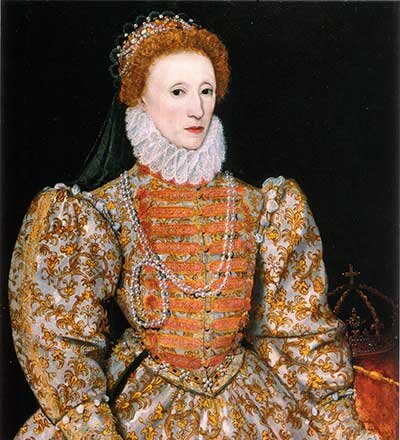
If you’ve been following the History Cycle at the Utah Shakespeare Festival for the last few years, then you’ll know what a crazy group the British royal family was. Like a giant soap opera, the Yorks, the Lancasters, and the Tudors all wove together to create a history that’s stranger than fiction. William Shakespeare, genius that he was, saw the craziness in that history— and he knew that it would make for some great stories.
In fact, this season’s history play is more “story” than history. Great tragedy though it is, Richard III is mostly fiction. From its crazy plot twists to perhaps Shakespeare’s greatest villain, practically everything in this play has been exaggerated, embellished, or even plain made-up.
Why would Shakespeare so blatantly ignore the history? After all, just over 100 years had passed between Richard III’s death and the play Richard III; Shakespeare almost definitely knew the real history. So why change the story? Well, the answer to that question can be found in one word: Elizabeth.
The Tudor dynasty came to power at a time of great upheaval and unrest in England. After all, England had been at war for about 150 years—starting with the Hundred Years War between England and France, and ending with the Wars of the Roses, a series of brutal civil wars. England was in constant turmoil during this time, the throne constantly being snatched from one family to the next. It was chaos, royal infighting to an extreme degree.
So when the forces of Henry Tudor— also known as Richmond— killed Richard III in battle, England was happy to allow Henry to take the throne. The very last king to win his throne in a battlefield, the new Henry VII ushered in a time of peace and prosperity— something England desperately needed. His son, Henry VIII, became king after him; and his granddaughter, Elizabeth, would eventually become one of England’s greatest queens.
By the time Shakespeare was born, the Tudor dynasty was fairly well established. Queen Elizabeth had sat on the throne for five years, and all seemed to be going well. However, Elizabeth was all too aware of her family’s history. The Wars of the Roses were not far distant. Elizabeth knew how easily different royal factions had stolen the crown. She knew that her grandfather, Henry VII, had a tenuous claim to the throne at best. It would be all too easy to kick the Tudors out and set up a new dynasty in their place. So Elizabeth, as a Tudor, wanted to send a clear message: The Tudors were the good guys.
If the Tudors were the heroes, then there must have been a villain. And the prime candidate was obvious: Richard III, the very man that Henry Tudor had overthrown. If the people of England were to be loyal to the House of Tudor, then they needed to believe that Richard III was evil— the most villainous man ever to prowl the earth. Shakespeare’s Queen Margaret explains it well: “Think that thy babes were sweeter than they were, / And he that slew them fouler than he is. / Battering thy loss makes the bad causer worse.” People had to believe that Richard was worse than he was. And so, Shakespeare’s Richard III had to show the worst that humanity has to offer.
William Shakespeare relied on Queen Elizabeth. She was a royal patron of the arts. We know that she attended several of his shows; there’s even stories that she requested certain characters to make appearances (she seems to have been a Falstaff fan). If the Queen liked a play, Shakespeare could be certain that others would. Her influence was invaluable. So the Bard had a vested interest in keeping her happy. Thus, he wrote Richard III for the Tudors. It’s no wonder, then, that he made Richard into such a villain. By doing so, he turned Henry VII— and, by extension, Elizabeth— into a national hero, capable of defeating archetypal evil.
In reality, Richard III wasn’t so bad. He wasn’t responsible for the deaths of Edward or Warwick; he never killed his brother Clarence; he didn’t manipulate Anne into marriage. There’s no evidence he murdered the princes in the tower. He never murdered his wife; she died of tuberculosis. And he wasn’t even a hunchback (though he did have scoliosis; the recent discovery of his body in Leicester proves that). But one thing is certain: Richard III wasn’t a villain, or a saint. He was a human, fallible, and nuanced, like every other English monarch.
And yet, Shakespeare’s Machiavellian villain, the “dreadful minister of hell,” the “unmanner’d dog,” the “defused infection of a man,” is one of the most exciting antagonists in the English language. It doesn’t matter that the depiction is completely inaccurate. What matters is that Shakespeare, through exaggeration and fiction, has created a story—and a character—that rings true and universal. Fictional or not, people will be marvelling at Shakespeare’s masterful villain for ages to come.
The (Recent) History of Richard III
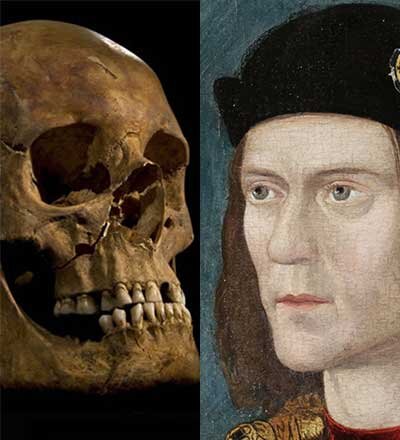
To say that England has had its fair share of infamous monarchs would be an understatement. From Henry VIII (and his many beheaded wives) to Bloody Mary, killer of nearly three hundred Protestants, the British crown of yesteryear conjures up images of greed, corruption, and murder. But none of England’s kings or queens are as notorious as the last of the Plantagenets: sinister Richard III, Britain’s most reviled royal.
After Edward IV died, leaving his son—Edward V—as king, Richard III took over as a regent. Essentially, he would act as king until Edward V was old enough to reign. Richard moved young king Edward and his younger brother into the tower of London— supposedly to prepare Edward for his coronation as king. However, while the boys were in the tower, word got out that the young king and his brother—due to a technicality—were considered illegitimate, and unable to take the throne. So, Richard swooped in and was crowned Richard III of England.
The young princes in the tower disappeared around this time. Whether they were murdered or not is unclear, but many people—Shakespeare included—believe that Richard was responsible for their deaths; he could have been trying to secure his place on the throne. Either way, the idea that Richard could have murdered two young children in his quest for power made many people very upset. Those who had supported Edward V now began to voice their anger at Richard.
A group of these nobles, upset at the way Richard had seized the throne and his possible role in the princes’ deaths, started a rebellion against Richard. One of the rebels, Henry Tudor, gathered troops against Richard at Bosworth Field. In the middle of this battle, Richard III was killed, and Henry Tudor crowned himself Henry VII of England—father to Henry VIII, and grandfather to Elizabeth I.
For centuries, no one was certain what had happened to Richard’s body. He was buried in a crude grave at Greyfriars Friary in Leicester, and when the Church was destroyed by Henry VIII around fifty years later, most people believed that the body had been thrown into the River Soar. A few people believed that his body may have been left underneath the church, but for more than five hundred years, nearly everyone assumed that his corpse had been lost.
However, although Richard was killed and his body lost, people didn’t lose interest in this notorious king. William Shakespeare wrote one of his most masterful plays based on Richard’s life. Shakespeare’s Richard is a heinous monster, up in the ranks of Iago and Macbeth as far as villainy goes. His play has been studied and performed, century after century, and audiences have been fascinated by Richard—both the character and the man.
In 2012, a group of Richard’s biggest fans—led by Philippa Langley, the president of the Scottish branch of the Richard III society—decided that Richard’s body had been lost long enough. It was time to find him. Research showed that the Leicester City Council parking lot had been built over the remains of the Greyfriars Friary, and that there was a chance—a very slim chance—that Richard III’s remains were somewhere under the parking lot.
They began digging, looking for the remains of the building—and in the very first trench they dug, archaeologists discovered a human skeleton. After looking closer, they discovered that the spine was curved, due to scoliosis—much like Shakespeare’s description of Richard the hunchback. They also discovered that the body appeared to have been thrown in unceremoniously, without a coffin or even a shroud. This, too, matched descriptions of Richard’s burial. There were multiple skull injuries and possibly an arrow lodged in his spine—indicating that this person had died in battle.
To prove that the corpse was really Richard’s, the team had to check for a DNA match with a relative. They tracked down a direct descendant of Richard’s older sister and found—to their amazement—that it was a match. The bones found under a parking lot, in the very first place they decided to dig, belonged to Richard III—the last of the Plantagenets. He was reburied in Leicester Cathedral in a ceremony attended by the Archbishop of Canterbury and several members of the royal family.
It’s easy to understand why people are still so interested in Richard III’s story. The history itself is fascinating, and the idea that a king could be so reviled and hated, and yet revered enough to warrant an archaeological dig—is almost Shakespearean in its irony. It’s hard to say, though, if people would be so interested in Richard if it weren’t for Shakespeare’s portrayal. After all, there are plenty of English kings whose bodies have been lost to time. It’s Shakespeare’s immortal words that keep us interested, keep us engaged in the history.
Shakespeare’s Richard III is one of his most powerful plays. The story of a man, consumed by his lust for power, is so chilling—and yet so universal—that it’s no wonder his legacy has lingered all these years. Regardless of the ancient history, and even the recent history, Richard III—the legend, the villain, the king—is immortalized in Shakespeare’s words.
Questions and Answers with Director Cameron Knight

This will be Cameron Knight’s first time directing at the Utah Shakespeare Festival, as he takes the helm of Richard III in the 2021 season. Hailing from Flint, Michigan, he has performed on stages across America and has worked in television, film, and commercials and voice-over. He has a growing number of directing credits (including work at Notre Dame Shakespeare Festival, the Theatre School at DePaul University, Carnegie Mellon University, and Twelve Peers Theatre) and has taught at some of the most prestigious actor training programs in America. The Festival recently conducted this question-and-answer interview via email.
The Utah Shakespeare Festival: This will be the sixth time the Utah Shakespeare Festival has produced Richard III, more than any other history and more than many other “popular” shows. What do you think the appeal of the play Richard III is?
Cameron Knight: I think it is shifting and I’ll be curious to discover that with the entire team and the audience. Traditionally, we (as an audience) love the charming villain that says what they want and go after it, by any means. In some productions, as is the case with many of Shakespeare’s villains, they cross a line at some point in the story and by then the audience has been on the ride with the villain and they feel as an accomplice to the characters’ actions. This serves as a potential catharsis; a mirror to society and warning of its potential dangers. I am curious what our relationship will be to characters like this now.
The Festival: On a similar note, the character Richard III seems to be a character that we “love to hate” but that we also are somehow attracted to. What is it in this character that makes him appeal to us in so many ways?
Knight: Richard gives us the opportunity to celebrate those aspects of ourselves that we would otherwise suppress. We all carry envy, greed, desire, entitlement and so much more frequently in our daily lives and often, without an outlet. Until recently, such behaviors were not so easily available to witness in our society; I’ll be very curious how the audience reacts to Richard’s actions given where we are today with so many similar actions being taken in our daily lives. Will this play still serve as an opportunity to catharsis, an example of how deeply we become corrupted by obsession, or will we be desensitized? We will explore the plays “new potential impact” on audiences.
The Festival: In your Preliminary Director’s Concept, you talk about “the amazing opportunity that we have before us to create productions that answer for social justice.” Would you elaborate on that idea?
Knight: Representation and identity matter. With each artistic endeavor we take on going forward we have an obligation to live up to our statements of equity and inclusion. This play, which is iconic in so many ways, has by its history, left people out of participating in productions: we can fix that and create a new standard for equity and inclusion. I am proud of the Festival’s commitment to do that work. We can create a theatre community that is representative of our deeply held beliefs. In order to do that we must take action, immediately and consistently.
The Festival: You and your team have cut the script some, which isn’t uncommon at most theatres. Can you explain a bit what you cut and why?
Knight: We wanted to cut for time and clarity: the history plays require the audience to have a shared knowledge of English hierarchy and history, we want to make that clear so that our audience doesn’t, at any time, feel left out of the story.
The Festival: This play can be brutal and violent at times. How much do you want to emphasize this in your production? Why?
Knight: It really can! I want to lean into it, mainly because it can provide an outlet for similar feelings in an audience, but also it is cathartic for all of us: that release, the sense of action being taken. It will be important for audiences to have something to respond to again; we will need to learn how to be together again in such an experience. The balance of well-spoken verse and strong action—I find is crucial for a play to really grab the audience. We are becoming more and more visual; as a result people need to sit in an experience in order to be moved by it, to be moved to action.
The Festival: As playgoers, what should we watch for in this production that may help us enjoy it and/or understand it more?
Knight: It’s been a year of pandemic and being isolated; come looking for community, the plays you remember and love, realized with a mix of new ideas and the quality you’ve grown to expect from the Festival. We have missed you and we are excited to share a story with you!
The Festival: This is your first time working at the Festival. What brought you here, and what are you looking forward to?
Knight: I have such a great knowledge of the Festival from so many friends that have and still work here, so I am excited to join that group. I’m excited to collaborate with old and new friends.
The Festival: Besides theatre business, what is the one thing you plan on doing while in Cedar City?
Knight: Hiking! It’s been a while since I’ve been to Cedar City, I always try to get a great hike in and see some of the amazing sights
The Festival: Is there anything else you would like to add?
Knight: I’m looking forward to creating live theatre again. I think the moment we are all in the space together will be electric!
Christmas Memories of Fred

Barbara and Fred C. Adams in front of their Christmas tree sometime in the early 1980s.
This will be the first Christmas that the Utah Shakespeare Festival will be without its founder, Fred C. Adams, who passed away on February 6, 2020. All of us (staff, patrons, and friends) have our favorite memories of him. But his family members, of course, have the most poignant and playful. So, in the spirit of Mr. Adams, who loved Christmas, family, and the Festival, we have gathered some reminiscences from his family to bring the spirit of the holidays into all our lives during this season.
Dorcas Woodward, daughter
“Some of my favorite Christmas memories of dad from when I was a little girl in the ’60s and early ’70s, center around the ‘Hall of Enchanted Trees’ in the Auditorium Theatre foyer. The tradition started when some of his college students couldn’t go home for Christmas, so he organized this project with and for them, and it turned into a Christmas gift for the whole community. They would spend hours collecting materials from the scene and costume shops and from local businesses to create imaginative ‘themed’ trees to fill the foyer. Dad always loved creating beautiful and interesting things, and this was the perfect outlet. . . . Our favorites were always the candy trees—until the year of the upside-down tree that hung from the ceiling. It was pure magic!”
“As a young woman I was the model for the Juliet statue [which is now in the Pedersen Shakespeare Character Garden]. In those days, they cast several miniatures and sold them to raise funds for the large statues. Oh, how I wanted one, but I knew they were considerably out of our family’s budget. One of our dear family friends who was a volunteer at the Festival for many years, bought one; and every time she saw me, would say ‘You are looking so beautiful in my living room!’ Years went by, and I figured there was no way I would ever own a Juliet. One Christmas morning the extended family was busily opening gifts when dad pushed a box toward me. I opened the box to see Juliet lying there. I started sobbing and looked up at Dad and said “How?” He was trying to control his emotions and gruffly said, ‘Well, you had to have her.’ Later, I found out that months earlier, he had gone to this friend and her children and explained things, and they had decided that Dad would pay her outstanding care center bills and when she passed away, Dorcas would have her Juliet.”
Glynis Neves, daughter
“One of the most vivid memories of my childhood Christmases with Dad is the decorating of the tree. When Dorcas, Addison, and I were all very young, Dad liked to have the tree just so! It was a showpiece! We would pick a tree out at a lot as a family. Those trees were always so beautiful! Thick white flocking with little bits of greenery peeking through. When the tree was delivered, it was always an ordeal to wrestle it into place in the front room. Dad would have several canvases placed on the floor to catch any flocking that might fall, and a ladder at the ready. Dad and at least two other men would wrestle that tree into place, centering it in the windows. Then the fun began! Mom and Dad had boxes and boxes of fancy ornaments. They would stack them on the sofas and dad would begin the decorating. We kids were not allowed to help: this was DAD’S tree! He would start at the top with small gold and white ornaments, and he would place them each carefully. As he moved down the tree, the ornaments grew bigger and shinier. Once all the ornaments were placed, Dad would pull out a small shoebox and call us kids around. Handing us each a small rag dipped in vinegar water, he would open the shoebox to reveal crystal teardrops. Our job was to polish those crystal drops until they sparkled. Dad would then hang them from the points of the branches. We were so proud to be a part of the decorating process.”
“Another memory surrounds Christmas Eve. This was a big family party at our house. All our family that lived in town came for dinner, games, and fun the night before Christmas. Dad would spend the day making potato soup, and mom would make pumpkin bread. As an extended family we would eat together: kids in one room and the adults in another. Dad would light the fireplace and have Christmas music playing in the background. It was magical! After dinner, we would all gather around, and the kids would put on a show. This was the one night of the year we all showcased talents. There were songs, violin pieces, Addison playing ‘Jingle Bells’ on the bugle mouthpiece, etc. The evening would end with Dad opening up the family Bible to read the story of the First Christmas. As he read, the children would act the story out, using costumes my mom and her sister put together from robes, towels, and bits of tinsel. We thought we were as good as anything we ever saw on the Festival stage! It was always wonderful to hear Dad reading the story in his ‘actor’ voice. It gives me chills, now, to remember it!”
Addison Adams, son
“Dad used to flock our Christmas tree using a canister vacuum to apply the flocking. His old neighbor and friend Bob Clark would find him a tree large enough for his eighteen-foot ceiling, and Dad would set up in the vacant lot next door and start applying bags of flocking. Now, the flocking nozzle would frequently clog with wet clumps of material, and Dad would dig it out with a butter knife. Once I reached the seasoned age of about five or six, I was allowed to hold the butter knife in between nozzle jams. I would also hold the ladder for Dad as he got the highest branches. After about half an hour mom would drag me away, to save my tender ears, as the machine’s nozzle got clogged more frequently. Mom always joked about this being where my colorful vocabulary all started!”
“In more recent years, I loved watching Dad interact with all the grandkids walking through Christmas Lane. The decorations were always magical to him.”
Joshua Adams, son
“Every year, Christmas Eve was spent at our house, and Dad would end each Christmas Eve reading the story of Christ’s birth from the Bible, followed by ‘’Twas the Night Before Christmas’ (not from the Bible). It’s this last memory that sticks with me, as I have now been living 3,000 miles away from Utah for thirteen years, unable to spend the holidays with my Utah family; so when my sons were very small, Dad recorded himself reciting this and attached it to a hard-back version of ‘’Twas the Night Before Christmas,’ and it is now one of the most cherished gifts my boys have of their late Grandfather—and for me. It allows that old memory to live on.”
“The second fond memory I have is short and silly. When the four of us children were small, Dad and Mom would have all of us sleep on the floor of their bedroom, so we couldn’t sneak out into the living room before he was ready for us on Christmas morning. It kept us all in one place, so they could do whatever voodoo they had to prep for Christmas day. Dad would NEVER allow us to leave their bedroom, no matter how early we woke up, and he’d twist the knife a bit and do his best to sleep past 8 a.m., then make us wait even longer as he went out, put on some music, started a fire, and made us orange juice and toast. This was all preparation for Dad to be able to have a good seat in the living room, so he could witness all of our faces, one by one, as he called to us to ‘come on out.’ His greatest Christmas gift was to see the joy on our faces—and maybe his yearly puzzle.”
Marina Sandall, granddaughter
“One of my favorite memories was the year Grandpa decided to switch from a gold to a purple Christmas. I was thrilled because purple was my favorite color. He had all the ornaments, decorations, even a purple nutcracker. But he couldn’t find the right lights for a Christmas tree, so we spent hours together hand painting the bulbs on strands of white lights, purple. And when we finished, he stood back and just stared at the tree in amazement. It was perfect.”
Olivia and Jamison Woodward, grandchildren
“I will always remember how excited Grandpa Fred was to decorate everything at Christmastime to make his home feel like a cozy winter wonderland. He loved putting up lights, blingy Christmas trees (the purple ones were favorites), and most of all a tiny, multi-colored, twinkling ceramic Christmas village. When we would visit, I remember seeing the scenes that he had so carefully constructed and being mesmerized by the miniature details. He was so proud of his beautiful decorations, and I think he loved them so much because of the joy that they brought to everyone.”
Katie Neves, granddaughter
I remember every year when I was a little girl, my grandpa would dress up as Ebenezer Scrooge for his role in A Christmas Carol: On the Air. While I would be in the kitchen helping my mom make Christmas treats, my grandpa would stalk out, top hat and cane, glasses perched on his nose, and a gravelly voice. He would walk into the kitchen, scowl around at all of us, then say, “Bah Humbug.” He made a pretty scary Scrooge! Then, after a beat, he’d wink at me, and I knew that he was still my grandpa underneath the costume. He’d whirl a scarf around his neck and leave the kitchen, and I knew I was in for a treat at the theatre that night.”
Alan Neves, son-in-law
“One of Fred’s great Christmas family traditions was sharing Disneyland with his kids and grandkids. He made it a year-long occurrence. Even though we would only travel there as a family every couple of years, he started it with Christmas and would hang tickets for each individual on the tree. That would build excitement for everyone and in turn would fuel his passion for this family tradition. This year will be difficult having Christmas without Fred but we will be forever grateful for him and the path he put forward for all of us.”
Gene Woodward, son-in-law
“A few years ago Dad had stopped at the huge Christmas store in Wisconsin and brought back cardboard glasses that you could wear, and when you looked at Christmas lights the glasses would turn the lights into stars, snowflakes, reindeer, Santa faces, etc. He couldn’t get over how magical they were. When the family was all together in December, he let the grandchildren all pick the one they wanted; and we headed off to Christmas Lane. He could hardly contain his excitement watching the grandkids swapping glasses to try all the different kinds and he giggled and oohed and aahed each time one would make him try on their glasses.”
Holiday Light Display DEBUTS at the Festival








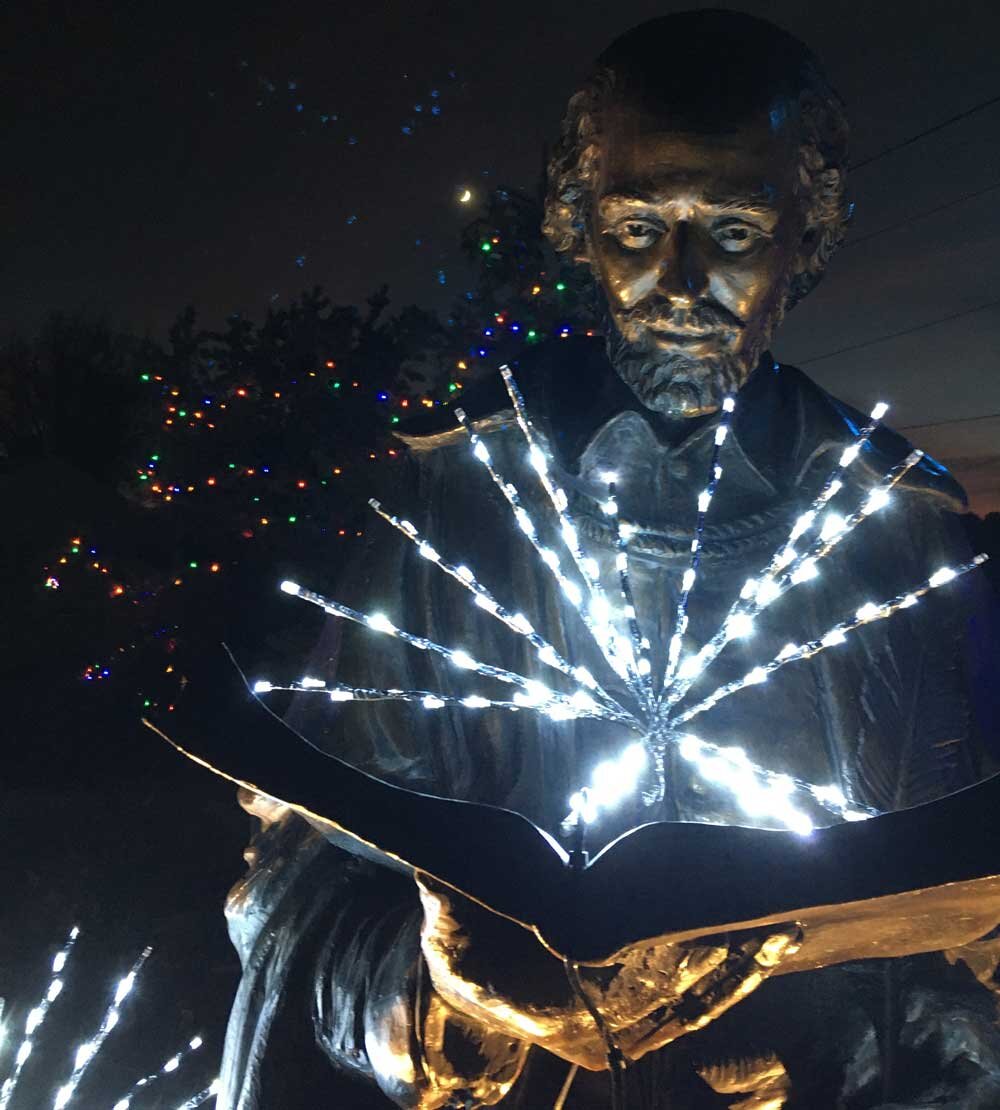

By Parker Bowring
The Utah Shakespeare Festival added its own spectacular lighting display to Cedar City’s historic downtown “All Is Bright” celebration this holiday season, promising an amazing new tradition of holiday spirit downtown, along Center Street, and all across the Beverley Center for the Arts.
Cedar City festivities were November 28 in front of the city offices, 10 N. Main Street, including holiday music, fire barrels, a visit from Santa, a Tuba band, and fireworks. The evening culminated as the lights are turned on downtown and at the Festival.
The Festival’s lighting display is part tribute to Founder Fred C. Adams’s love of Christmas lights and part the beginning of a holiday tradition the Festival hopes to build on every year. As such, the Tony Award-winning theatre company has called in the help of professional theatre and architectural lighting designers Tom and Donna Ruzika, who have joined forces with Festival technicians and artists to create a display that will dazzle with over 100,000 lights, wreaths, icicles, and other decorations.
The husband and wife design team have enormous experience, including time at the Festival. Tom designed lighting for plays at the Festival in 1973, the year they were married; and Donna has designed nearly seventy shows since 1998. “Coming back to the Festival is a homecoming,” said Tom.
The Ruzikas’ vision for the Festival lights combines traditional Christmas lights and music with theatrical and architectural lighting. They hope that holiday revelers will be immersed in a festive, glittering environment as they stroll through the Festival grounds.
Due to their background they are envisioning this exciting project as if it were a Shakespeare play. “We are approaching this project as if the Festival grounds are a performance, as if the lights are the actors,” said Donna.
“The end result is to hopefully have the community remember the Festival during the winter and enjoy an enchanted magical area to help everyone get out of what we are going through this year. It will be something very special,” said Tom.
In order to create a memorable experience Donna strived for a holiday theatricality as she imagined the Shakespeare theatres decorated in thousands of lights, wreaths, and decorations, with familiar and nostalgic holiday songs playing on the Festival’s outdoor sound system. The crown of that theatricality is a seven-foot star on the top of the Engelstad Shakespeare Theatre that will be visible from much of Cedar City.
“These lights are also a reminder that we are still here and working toward a brighter future when we can be together again in the theatre,” said Festival Production Manager Richard Girtain. “I believe creating this aesthetically pleasing holiday display will provide a visitor some peace and holiday cheer in a very turbulent year.”
Cedar City has extended its glittering display down Center Street this year between Main Street and 100 West, bringing it nearly to the Festival’s front door, making it easy for the Festival to tie into the celebration. “I’m so excited that the Festival can be part of the Cedar City celebration and grateful to the wonderful lighting designers and our production staff for making it all happen,” said Executive Producer Frank Mack. “We are also grateful to Cedar City, Iron County, and Visit Cedar City • Brian Head for their support for this display. Many, many people have contributed to make this a success.”
“Cedar City and Iron County have a truly unique, hometown holiday attraction with the lights downtown, at the Frontier Homestead State Park, and at the Utah Shakespeare Festival grounds,” added Maria Twitchell, executive director of Visit Cedar City • Brian Head — the tourism bureau for Iron County. “In this time of Covid, it’s important we support efforts that not only celebrate the season but also bring families together with an activity that can easily accommodate social distancing.”
“There’s nothing like a small-town Christmas in Festival City!” concluded Cedar City Mayor Maile Wilson-Edwards. “This year, more than others, we needed some holiday cheer, and it’s been amazing to see the community join in on the fun. The true draw, however, will be the new Utah Shakespeare Festival lights, which will certainly add to the downtown experience and make Cedar City an even more phenomenal Christmas destination.”


